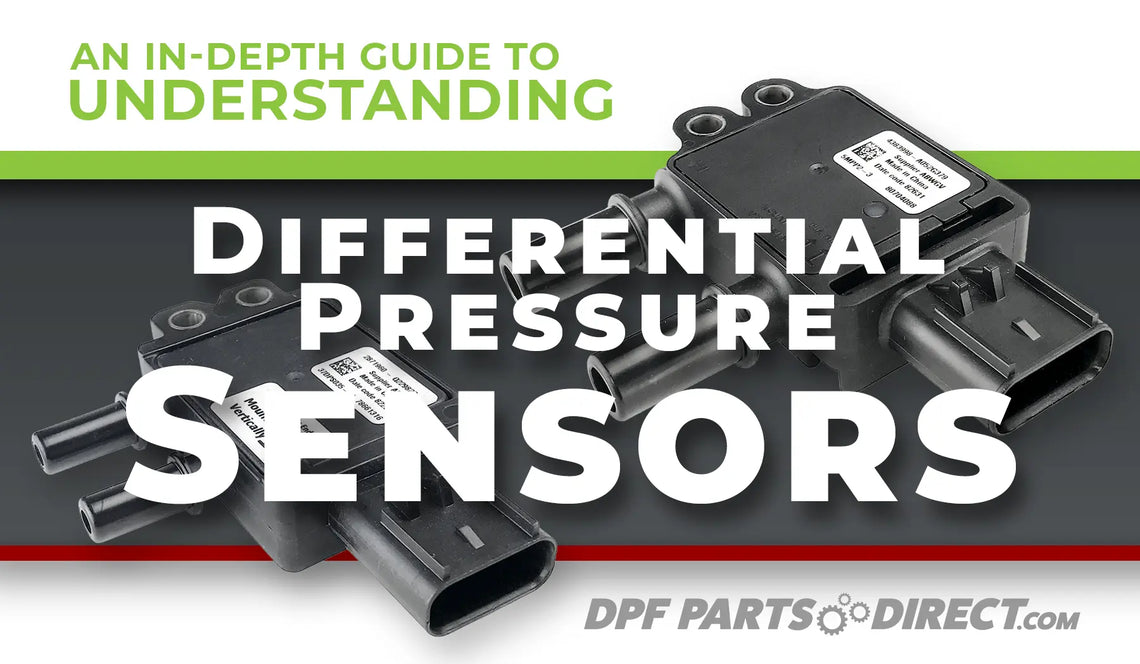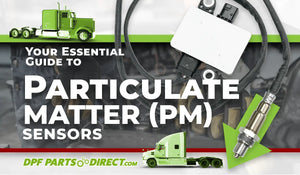Diesel Emissions System Sensors - DPF Differential Pressure Sensors | Full Guide
What is a DPF differential pressure sensor? What function does it perform inside the diesel emissions system? Why do they fail? Where should you buy your replacement DPF sensor should it need to be replaced?
For many years, operators of commercial trucks have been trying to increase uptime and minimize unscheduled and costly roadside repair events. It is extremely frustrating when a work truck that is supposed to earn you money is unable to do what it is designed to do because a sensor has failed, and it is even worse when it breaks down and then requires a mobile mechanic and/or a tow to a repair shop to get it fixed and back on the road.
Diesel emissions systems rely on sensors to send signals to control modules when maintenance on the aftertreatment systems is required or when something is no longer functioning properly and requires a repair.
The differential pressure sensor is one of the sensors in the diesel emissions system that communicates with ECU and the power-train control module (PCM) critical information about exhaust backpressure caused by the accumulation of diesel particulate matter (DPM) or soot.
When this sensor is not working properly it compromises the regeneration process and will eventually lead to diesel emissions system failure.
Understanding The Function Of A DPF Differential Pressure Sensor
The differential pressure sensor on a diesel particulate filter (DPF) is used by the ECU to monitor backpressure and determine when regeneration is required to clear DPM or soot from the system. This enables the diesel particulate filter to remove more contaminants from the system and keep your diesel emission system working properly.
Without this sensor, the DPF would fill up with diesel particulate matter or soot and the truck would eventually be put into derate and would be restricted to limp mode which can be as little as 5 MPH. When this happens it creates all kinds of problems for the truck operator and the fleet.
How Does A Differential Pressure Sensor Work?
The sensor is connected to two hoses – one upstream and one downstream from the diesel particulate filter. By comparing the pressure at these two points, the sensor can track the buildup of soot within the DPF and trigger the PCM to do a regeneration cycle at the appropriate time.
Where Is The DPF Differential Pressure Sensor Located?
The pressure sensor location is a bit different for each make and model. However, it is usually mounted on the aftertreatment assembly near the DPFs.
Why Do DPF Differential Pressure Sensors Fail?
Electrical sensors in an engine have wires to the ECU that can be damaged from road vibrations or crack and melt from extreme heat. The sensor hoses can become clogged from soot in the exhaust system just like the DPF.
When diesel particulate matter blocks one or both of these airways to the sensor, the sensor can no longer accurately determine pressure changes, which can result in catastrophic damage to the DPF and ultimately the engine.
What Are The Symptoms Of A DPF Differential Pressure Sensor Failure?
The symptoms of a diesel particulate filter differential pressure sensor malfunction are not always easily detected because they mimic many of the symptoms of other components of the diesel emissions systems failing. This also happens when the sensor fails because it leads to the DPF becoming clogged. Sometimes the DPF is misdiagnosed as the problem and replaced only to quickly fail again because the sensor is the actual issue.
When the diesel particulate filter is not regenerating properly due to the faulty DPF sensor failing you may experience some of or all of the below symptoms:
- Poor engine performance
- Poor fuel economy
- High engine temperatures
- High transmission temperatures
- An increase in black smoke (soot) from the exhaust
- Check engine light and various fault codes
A DPF pressure sensor is necessary to keep the DPF free from diesel particulate matter and soot, and if the DPF is plugged, the regeneration process will not fix it. It will need to either be removed, professionally cleaned, or replaced, both options being much more than the cost of diagnosing and replacing a faulty sensor.
In the most extreme cases, a DPF failing can create an environment where the exhaust gas can not be fully purged. The exhaust backpressure will build and with nowhere to go can end up back in the combustion chamber causing the soot to mix with the engine oil. Since soot is abrasive, when it is mixed with oil, will cause premature wear to the engine components like the bearings.
The diesel fuel that normally escapes through the exhaust system during the regeneration cycle only partially burns. This leftover diesel fuel can wash away the oil film that protects internal engine components and can cause catastrophic failure.
Diagnosing And Replacing A DPF Sensor
Before you change the DPF sensor, determine if the DPF pressure sensor needs to be replaced, or if carbon cleaning will get it operational. If cleaning the soot and other carbon deposits from the sensor and hoses don’t work, or if the sensor is melted or cracked, it needs to be replaced. Be careful in removing the sensor and hoses, as there are other sensors in this area that can be easily damaged.
How To Diagnose A DPF Pressure Sensor
If everything passes a physical inspection and cleaning the sensor doesn’t work, you can test the DPF sensors using a multimeter set to 20V and a pressure gauge. Below we've included a step-by-step guide to help:
- To test if your battery is working properly, you'll need to connect the multimeter ground with one lead connected directly onto its negative terminal and run a quick "plausibility" check. If all's well on this end then it should show 12 volts or more when reading from the device’s scale!
- To find which wires are being used for each signal in your car, consult the manual. The ground and 5-volt reference should be identified first with their respective colored codes while backprobing any other signals that might need servicing.
- Turn on the ignition switch without starting the engine. The multimeter should normally display a voltage between 4.5 to 5 volts for referencing the 5-volt, a solid 0 volts for the ground wire, and anywhere between 0.5 and 4.5 volts for the signal wire. Consult OEM factory service information for the exact vehicle specs if needed.
- The engine should start with the signal wire back-probed.
- It's important to rev the engine and check for voltage changes before testing anything else. If you don't notice a voltage change, first test all of their connecting hoses with a pressure gauge.
- While the engine is running you will then need to remove the hoses from the sensor.
- Using a pressure gauge, measure both hoses. If you are wanting to be a little more accurate you can use an exhaust backpressure gauge that measures between 0-15 PSI.
- Lastly, check the signal voltage one last time. The voltage should read a value between the pressure values of both hoses. So if the front hose reads 1 PSI and the rear hose reads half PSI, the signal wire voltage should read somewhere around .8 volts.
If you see that your voltage is off or there are huge differences in pressure values, then it could be time for a new DPF sensor.
Where To Buy DPF Differential Pressure Sensors Online
To find a high-quality new DPF replacement pressure sensor, it’s important to purchase the right part. You don’t want to go to all the effort and spend valuable time and money replacing a sensor only to have it fail prematurely because it is a poor-quality replacement part.
The online store you use should provide you with access to industry experts to help you if you run into an unexpected problem changing the sensor. It should also carry a wide selection of sensors and have parts in stock. Finally, if you’re looking to save money over OEM prices, consider an aftermarket DPF pressure sensor from a company based in North America.
DPFPartsDirect.com meets all these qualifications. We proudly carry Redline Emissions Products® differential pressure sensors for many makes and models, and our parts meet or exceed OEM parameters.










Comments 0